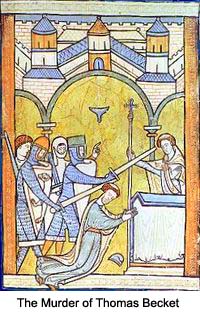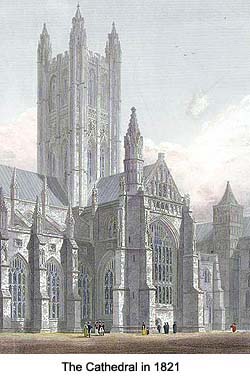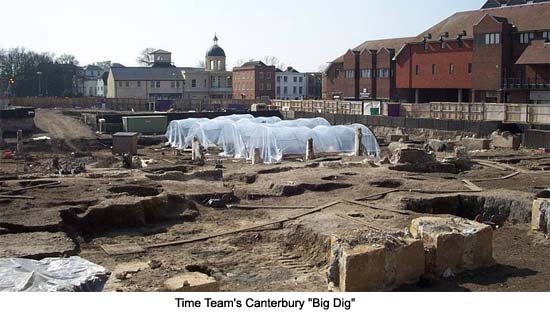TIMELINE: Canterbury
by Darcy Lewis

Ca. 100: Romans take over the Celtic settlement of Durovernum and rebuild it, calling the new town Durovernum Cantiacorum.
Ca. 200: The Romans build a wall around the town.
Ca. 400: After the Romans leave Britain, town life breaks down and Canterbury is probably abandoned. A few farmers continue living inside the walls and may even grow crops and raise animals there but Canterbury ceases to be a town.
597: The man eventually canonized as St. Augustine, sent to England on a papal mission, builds a priory on the site of the present Canterbury Cathedral.
602: St. Augustine rededicates a deserted Roman church in Canterbury.
603: Canterbury is chosen to be the seat of the first archbishop.
Ca. 630: A mint is active in Canterbury. The earliest coins are silver.
842: The Danes first raid Canterbury.
851: The Danes raid Canterbury again.
1011: The Danes return and lay siege to Canterbury, capturing it after 20 days. They kill the archbishop and burn the cathedral, which is quickly rebuilt.
1067: The original Saxon church is destroyed by fire.
1070-1077: The newly powerful Normans rebuild the church.
1072: The Accord of Winchester designates Canterbury as the supreme archdiocese in England, taking primacy over that of York.
1170: In Canterbury's most infamous crime, Archbishop Thomas Becket is murdered within Canterbury Cathedral on orders from King Henry II.
1174: The Norman church burns and is rebuilt after 1175.
1190: Eastbridge Hospital is built as a shelter for poor pilgrims.
1220: Becket's body is entombed in a new shrine within the cathedral.
1376: Edward the Black Prince, heir to King Edward III, is buried in Canterbury Cathedral.
1380: Archbishop Sudbury orders the construction of a new West Gate to the city.
1387: Geoffrey Chaucer writes The Canterbury Tales, assuring Canterbury of lasting literary fame.
1413: King Henry IV is buried in Canterbury Cathedral.
1517: Christchurch Gate is built.
1535: The head of Catholic martyr Sir Thomas More is buried at the church of St. Dunstan's, Canterbury.
1538: Troops of King Henry VIII destroy Becket's shrine.
1558: Cardinal Pole, the last Catholic Archbishop of Canterbury, dies.
1564: The dramatist Christopher Marlowe is baptized in St. George's Church.
1567: The first Belgian weavers fleeing religious persecution arrive in Canterbury from the Continent.

1573: Queen Elizabeth I visits Canterbury in 1573 and entertains the Duke of Alençon at the Crown Inn, perhaps considering -- then rejecting -- marriage to the gentleman.
1642: The Puritans sack the cathedral in the Civil War.
1660: Upon the Restoration, the Church of England is re-established at the cathedral and repairs begin.
1704: Cathedral repairs are finally complete.
1780s: The gates of Canterbury (except Westgate) are demolished because they impede traffic flow.
1790: Dane John Gardens are laid out.
1830: The pioneering Canterbury & Whitstable Railway opens with Canterbury as its terminus.
1832: The remains of King Henry IV are disinterred to disprove the old story that his body had been tossed overboard in a heavy storm on its final trip to Canterbury. Onlookers are shocked that his russet beard is still visible.
1846: The South Eastern Railway opens the Canterbury West station, the city's first. The line to Ramsgate is completed two months later.
1860: The London, Chatham & Dover Railway opens the Canterbury East station, the more central of the two.
1906: The Westgate museum opens in, where else, the city's West Gate.
1942: The Luftwaffe targets the city in the Baedeker Blitz. Canterbury is severely damaged.
1944: Film directors Michael Powell and Emeric Pressburger celebrate the city in their film A Canterbury Tale.
1953: The pioneering Canterbury & Whitstable Railway closes.
1954: The Cathedral's library is finally rebuilt following the Blitz in a timeframe typical for damaged English cities.
1962: Canterbury University is built.
1976: St. Augustine's College, a Church of England theological college, closes. It had opened in 1848.
1982: Pope John Paul II visits Canterbury and, with Archbishop Robert Runcie, prays at the site of St. Thomas Becket's martyrdom.
1986: The Altar of the Sword's Point (site of the martyrdom) is restored.
2001: A local metal detector enthusiast makes a spectacular discovery while scanning a newly plowed field: a solid gold Bronze Age cup.
2003: The present Archbishop of Canterbury, Rowan Williams, is enthroned as the 104th archbishop.
2004-2005: The Whitefriars area of the city undergoes major redevelopment and the associated archeological research is known as the "Big Dig."

Related Articles:
- Canterbury: Still the Perfect Pilgrimage!, by Julia Hickey
- https://www.timetravel-britain.com/articles/towns/canterbury.shtml
- Canterbury Cathedral, by John P. Seely
- https://www.timetravel-britain.com/articles/churches/canterbury.shtml
- Read More about:
- The Hospital of St. Thomas
- St. Augustine's Abbey
- The History of the Archbishop of Canterbury
- The Canterbury Tales
- Thomas Becket
Darcy Lewis is an award-winning freelance writer whose articles have appeared in Writer's Digest, HGTV Ideas, Home, and the Chicago Tribune, among many other publications. Much of Darcy's knowledge of British history can be traced to her work as a history major specializing in pre-modern England at Brown University in Providence, RI. But her passion has deeper roots: Darcy's English mother, who is an endless treasure trove of stories about "how we do things at Home."
Article © 2006 Darcy Lewis
Becket image courtesy of Wikipedia.org. "Big Dig" © Michael Pead (http://www.michaelpead.co.uk/photography/kent/)
| 